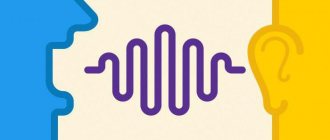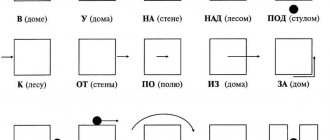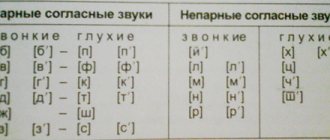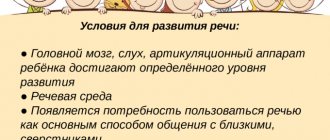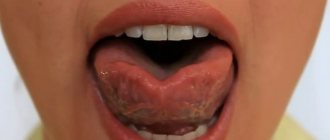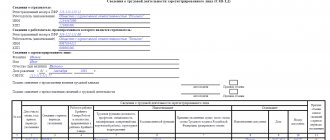To pronounce consonants, you need an obstacle in the path of the air stream in the oral cavity. Which speech organs create this obstacle? The answers to this question constitute a classification of consonants according to place of articulation.
All consonant letters and the consonant sounds they denote in the Russian literary language are classified according to four criteria:
- By participation in their formation of tone (voice) and noise;
- At the place of noise generation, that is, at the place of formation of an obstacle that the exhaled air encounters;
- According to the method of noise generation, that is, according to the method of overcoming an obstacle;
- By the presence or absence of softening, or palatalization (from the Latin palatum “soft palate”).
Each consonant sound can be characterized by these four features, and each consonant is distinguished from every other consonant by a combination of these four features.
When vowel sounds are formed, the air stream, leaving the larynx, does not encounter any obstacles in the articulatory department of the speech apparatus.
For the formation of consonants, the presence of obstacles is a necessary condition. In phonetics, all consonant sounds are classified, this is very convenient when you need to tell a person how to correctly produce a sound.
Articulatory apparatus
All speech organs are divided into active and passive. Active ones are moving, passive ones are motionless.
The active organ is the lower lip, the passive organ is the upper lip. In other words, the lower lip approaches the upper; The consonants [p], [p'], [b], [b'], [m], [m'] are pronounced. The active organ is the lower lip, the passive organ is the upper teeth; The consonants [f], [f'], [v], [v'] are pronounced. These are labial consonants.
The active organ is the front part of the tongue, the passive organ is the teeth; The consonants are pronounced [t], [t'], [d], [D'b [s], [s'], [z], [z'], [ts], [n], [n'], [l], [l']. These are dental consonants.
The active organ is the front part of the tongue, the passive organ is the alveoli (bulges above the teeth - the very front part of the palate); The consonants [w], [iG], [zh], [zh'], [h'], [r], [r'] are pronounced. These are anteropalatal consonants.
The active organ is the middle part of the tongue, the passive organ is the middle part of the palate; pronounced yot [j] (yama, hedgehog, spruce, south - the first sound in these words is [j], i.e. [jaMb], [join], [jan'], [jyx]). These are midpalatal consonants.
The active organ is the back of the tongue, the passive organ is the palate; The consonants [k], [k'], [g], [g'], [x], [x'] are pronounced. These are velar consonants.
Articulation exercises
Clearly defined articulation is the key to beautiful and correct diction. Many children experience difficulty pronouncing certain sounds during the period of active development of their speech apparatus.
If a person has diction defects (burr, lisp, distorted pronunciation of individual sounds, etc.), it is necessary to correct such defects with the help of special exercises.
Speech gymnastics can be performed both in classes with a speech therapist and independently.
Let us note that pronouncing sonorant consonants causes the greatest difficulties for both children and adults. Such corrective exercises to develop the correct method of articulation can completely rid a person of speech defects.
All exercises must be performed in front of a mirror. The key to correct articulation is to perform movements only with the speech organs. Often, people with diction defects have the following feature: when articulating certain phonemes, movement is transferred to the limbs or parts of the body (for example, arms or legs).
Therefore, when performing corrective exercises, it is necessary to use a full-length mirror in order to identify excessive gestures in time.
Tongue twisters using words that contain specific hard-to-pronounce sounds can be a good way to develop pronunciation. After a persistent improvement in the articulation of the necessary sounds begins to appear, you can move on to pronouncing tongue twisters with an obstacle in the mouth. These could be small pebbles, nuts, candies or a wine cork.
Consonant sounds based on the participation of voice and noise
Based on the participation of voice and noise, all consonant sounds are divided into sonorant and noisy.
Sonorant consonants are those in which the voice and slight noise are involved in their formation. When these consonants are formed, the glottis is narrowed, the vocal cords are tense and vibrate under the influence of exhaled air. Sonorants in the Russian literary language include: [р], [л], [м], [н] and [р'], [л'], [м'], [н'], [й].
Noisy consonants are those in the formation of which noise predominates over voice. From this point of view, they are divided into voiced noisy sounds, the formation of which is characterized by noise accompanied by voice, and voiceless noisy sounds, which are formed only by noise (the pronunciation of voiceless noisy sounds is determined by the fact that the glottis is open and the vocal cords are not tense and do not vibrate).
Where is the consonant sound formed?
The voiced noisy sounds of the Russian literary language are [b], [b'], [v] and [v'], [d] and [d'], [z] and [z'], [zh], [g] , [g'] (pity, doctor, dawn, nail, storm).
Voiceless noisy ones - [p] and [p'], [f] and [f'], [t] and [t'], [s], [s'], [sh], [sh'], [ts ], [h '], [k], [k '], [x], [x'] (cap, folklore, secret, whisper, noise, buckwheat, quote, store, chic).
Types of alternations
There are two types of alternations of sounds - positional and non-positional. Positional
alternations are caused by phonetic conditions: the position of stress and the properties of neighboring sounds. The set of such conditions is called phonetic position. All the examples of alternations given so far have been positional.
Non-positional
alternations are caused by reasons beyond the competence of phonetics.
They are also called grammaticalized or morphonological. For example, alternating [o || á] in the roots of the words u dvoyat – u dvaivat ,
dig – dig in due
to the presence or
absence of the
suffix -iva
.
It's easy to verify this. In the words double
and
double
the root vowel is in the same phonetic position - under stress, between the sounds [v..i].
Therefore, this alternation is not determined by phonetic position. On the contrary, an exhaustive selection of cognate words with
and without -iva
Phonetics considers only positional alternations. Non-positional ones will be considered further, within the framework of those word-formation and inflectional processes in which they manifest themselves.
Consonants by place of noise production
According to the place of noise formation, all consonants are divided into labial and lingual, since their formation involves two active organs of speech - lips and tongue: the lower lip plays an active role in the formation of labial consonants, and the tongue plays an active role in the formation of lingual consonants.
The active organs of speech act (articulate) in relation to the passive ones - the upper lip, alveoli, teeth, hard palate.
Labial and lingual consonants are divided into a number of smaller groups depending on which passive organs the active ones act on.
Labial consonants are divided into labiolabial and labiodental.
Labiolabial consonants are formed by closing the lower lip with the upper lip. These include: [p], [p'], [b], [b'], [m], [m'].
Labiodental consonants are formed by bringing the lower lip closer to the upper teeth. These include: [f], [f'], [v], [v'].
Lingual consonants are divided into anterior, midlingual and posterior lingual, depending on which part of the tongue - anterior, middle or posterior - plays an active role in the formation of sound.
Front-lingual consonants are divided into two groups: dental and palatodental.
Paired consonants
When forming dental consonants, the front part of the tongue closes or approaches the upper teeth. These include: [t], [t'], [d], [d'], [s], [s'], [z], [z'], [ts], [n], [n '], [l], [l']. When forming palatodental consonants, the front part of the tongue rises to the front part of the palate and there an obstruction is created in the area of the alveoli. These include: [w], [w], [w'], [w'], [h'], [p], [p'].
the middle lingual , and according to the passive organ the middle palatal , in the Russian language. When it is formed, the middle part of the tongue rises to the middle palate. Rear-lingual , and by the passive organ velar , the sounds [k], [g], [x], [k'], [g'], [x'] are formed by closure ([k, g]) or approach ([x] ) the back of the tongue with a fixed posterior palate.
What does the word... mean?
Life is changing rapidly. Integration with other cultures, information interaction, exchange of culinary traditions and general evolution are reflected in the vocabulary of the Russian language. Vocabulary and language style change in accordance with the spirit of the times. The vocabulary is regularly updated with new definitions. Sometimes, in order to stay on topic, you have to look up what a word means or the meaning of expressions. Explanatory dictionaries will help you with this, since changes in vocabulary are immediately reflected in them.
Dictionary online
More recently, to find out what a foreign term or unknown expression means, people went to reading rooms. This period was experienced by your parents’ generation. Yes, yes, libraries were unified centers and sources of reference information. Wealthier families bought dictionary encyclopedias in printed form. Many volumes occupied entire mezzanines, and yet did not contain all the abundance of information on many specific topics. With the development of technology, the advent of the Internet and electronic media, access to bodies of knowledge has become easier and more immediate. In our online dictionary you will find an interpretation of the meaning and origin in 2-3 seconds.
Why are sensible thesauri needed and why do they remain relevant? Most people would rather avoid something funny than make excuses. In the age of popularization of social networks, information spreads instantly, and being considered ignorant is, you see, an unenviable prospect. The Russian explanatory dictionary online on the how-to-all website is a resource for supporting competence in any matter. Look here so as not to lose face. He will explain the semantics, what meaning the word has in the specified context, its history.
Consonants according to the method of noise production
According to the method of noise production, or according to the method of overcoming an obstacle, consonants are divided into stops (plosives), fricatives (frictions), affricates (stop-frictions), stop-passes, and tremors (vibrants).
Closing (plosive) consonants are formed by the complete closure of the organs of pronunciation, and therefore the air, encountering this barrier, tears it apart with force, as a result of which the noise characteristic of these consonants arises.
Stops in the Russian language include: [p], [p.'], [b], [b'], [t], [t'], [d], [d'], [k], [k '], [g], [g'].
Fricative (frictional) consonants are formed by incomplete convergence of the active and passive organs of speech, as a result of which a narrow gap remains between them through which air passes; the noise is generated by the friction of air against the walls of the crack.
Fricative consonants are: [f], [f'], [v], [v'], [s], [s'], [z], [z'], [sh], [zh], [sh '], [th], [x], [x']. Affricates are sounds that are complex in the functioning of the speech organs: at the initial stage of articulation they are formed as stops, that is, by completely closing the speech organs, but at the end of articulation there is not an instantaneous opening of the stop, but its transition into a gap, as in fricatives.
In the Russian literary language there are two affricates: [ts] (t + s) and [ch'] (t' + sh').
Close-passive consonants are those whose formation is characterized by complete closure of the speech organs with the simultaneous passage of air through the oral cavity or nasal cavity. Depending on which cavity the air passes through, the occipital passages are divided into nasal and lateral.
Nasal occlusions include: [n], [n'], [m], [m']; to the lateral ones - [l], [l '] (the side of the tongue is adjacent to the upper jaw).
Trembling consonants are consonants, during the formation of which the tip of the tongue either closes or opens with the alveoli during the passage of an air stream (vibrates). Trembling ones in Russian include: [р], [р'].
A more clear description of consonants by method of formation will look like this: Hard and soft consonants, voiced and voiceless consonants, stops and fricatives, and others - the table will show everything.
Table of classification of consonant sounds in Russian
| Method of education | Place of education | ||||||
| Labial | lingual | ||||||
| Labiolabial | Labiodental | Forelingual | Middle language | Rear lingual | |||
| Dental | Anteropalatal | Midpalatal | Postopalatines | ||||
| Occlusive | Oral | [b] [ts] [b'] [n '] | [d] [t] [d'] [t'] | [g] [k] [g'] [k'] | |||
| Nasals | [mm'] | [n] [n'] | |||||
| Slotted | Median | [v] [f] [v '] [f'] | [z] [s] [z'] [s'] | [w] [w] [w'] [w'] | [th] | [x] [x'] | |
| Lateral | [l] [l'] | ||||||
| Africans | [ts] | [h'] | |||||
| Trembling | [r] [r'] | ||||||
Difficulties in Russian
What about the sonants that cause the greatest difficulty in pronunciation for Russian-speaking people? Consonants, and do not cause any particular problems. But incorrect articulation occurs in almost every third child.
Note!
- The articulation of Russian is different from the articulation of this sonant in other language systems.
- Russian, unlike English, is solid and has clearer articulation.
During the development of the speech apparatus, these phonemes are the most difficult for a child. If you do not seek help from a speech therapist at an early age and start a problem, it will be much more difficult to correct it in adulthood. As a rule, adults who have such a defect no longer undertake to correct it.
How are sonorant sounds formed?
Among voiced consonants, sonorant consonants stand out for their special sonority ( Latin sonorus - “sonorous”), in the formation of which the share of noise is minimal, and the voice prevails, that is, the sound comes out relatively freely. This group of consonants includes 9 sounds that correspond to the letters of the alphabet:
- the letter “th” is the sound [th'];
- the letter “l” is the sounds [l] or [l'];
- the letter “m” is the sounds [m] or [m'];
- the letter “n” is the sounds [n] or [n'];
- the letter “p” is the sounds [p] or [p'].
If air leaves through the nose, sonorant sounds [m], [m'], [n], [n'] are formed:
- mask [m a s k a];
- meat [m' a s a];
- leg [n a g a];
- nanny [n' a n' a]
Air can pass into the passage between the lateral edges of the cheeks and tongue. Then the sonorant sounds [l], [l'] are born:
- smile [smile];
- sheet [l' and s t]
If the tip of the tongue rises to the alveoli and trembles under the influence of an air stream, sonorant sounds [р], [р'] appear:
- frame [frame];
- ripple [p' a b' ]
As you can see, the listed sonorant sounds have pairs based on softness/hardness.
When the gap is wide enough for exhaled air between the middle part of the back of the tongue and the hard palate, a sonorant soft sound [th'] appears. It is closest to vowels, since there is almost no noise. He has no pair based on hardness. The sonorant consonant sound [th'] is unpaired soft:
- jay [s o y' k a];
- edge [edge']
Unpaired sonorous sounds
Sonorant sounds [l], [l'], [m], [m'], [n], [n'], [r], [r'], [th'] do not have a pair among voiceless consonants. In terms of voicedness/voicelessness, they are all unpaired. At the end of a word and in the position before voiceless consonants, unlike other voiced consonants, sonorants are not devoiced.
Let's compare:
- knight [s'] - wind, pretense;
- crew [w] - angle, cocked hat;
- plant [t] - cocoon, horse;
- impulse [f] - gnome, breakdown.
There is no voicing of voiceless consonants before sonorant sounds, for example:
crust, bun, cantata, light bulb.
Compare:
- anecdote [a n' i g d o t]
- station [v a g z a l]
- mowing [k a z' b a].

